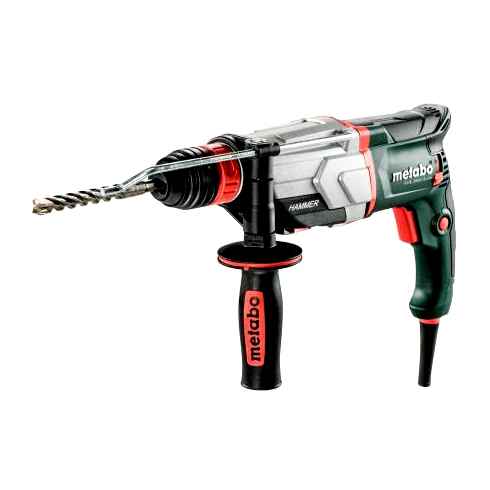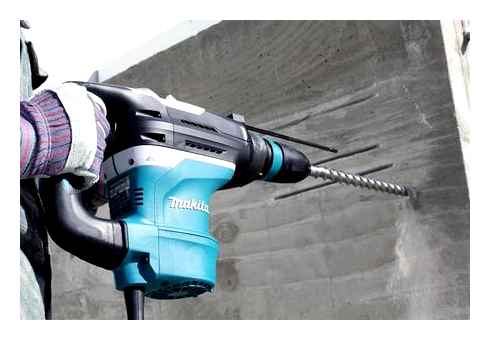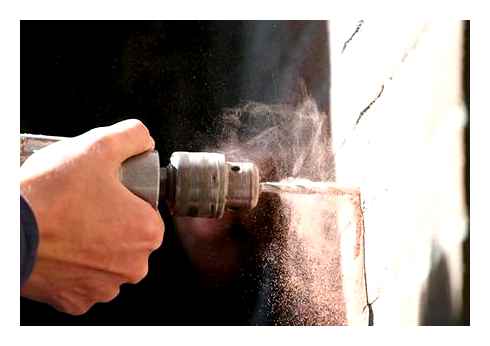How to drill with a perforator without dust. Safety precautions
Professional builders have a special tool at their disposal to combat the resulting flour: a nozzle on the drill or auger, which is connected to the hose from the vacuum cleaner. Such an addition to the peorator helps to collect debris very cleanly, but it has a number of disadvantages:
- You have to spend money to buy a nozzle. Such expenses are appropriate if you have to drill constantly. But if you occasionally have to drill one or two holes in the ceiling or wall, it is not rational to buy a special attachment.
- As a rule, the use of the nozzle requires the help of a partner, who will hold the vacuum cleaner. At home, for the same tasks one uses improvised devices made by one’s own hands.
How to choose a drill
Peorator is not a cheap enough tool, so we’ll tell you what parameters to pay attention to when buying a drill percussion type.
- So, the power of the tool itself should be at least 600 watts.
- The speed should go up to 2,500 and it would be great if the drill had a stepless adjustment of these revolutions, from zero to maximum.
- Preferably, the tool should be reversible so that when the drill bit jams, you can twist it back out again.
- Of course, if you plan to drill in concrete and brick, you can not do without a hammer function, so your drill should be a hammer drill.
Vacuum Cleaner
To keep your respiratory system safe and to minimize the amount of waste while working with a drill or rotary tool, a normal vacuum cleaner can be used. In this case it is more convenient to work with a partner. The vacuum cleaner tube should be directed to the hole to be drilled as you work, so that while drilling, the vacuum cleaner sucks up the dirt that occurs in parallel. In this way, dust and debris will be directed into the machinery tank and the eyes and respiratory tract will be shielded.
Learn how to drill in concrete correctly and without dust. How to drill a hole without dust
I recently needed to make just one hole with a peorator in the wall for a dowel nail.
Immediately remembered all the simple ways not to make a mess while doing so:
Using a paper envelope taped to the wall and using a disposable cup.
These methods are time-tested, but I wanted to think of an even more convenient way. The idea of using a dishwashing sponge just happened to occur to me.
It has several advantages: it is accessible, reusable, holds dust well when wet, and serves as a kind of filter.
Materials and tools
We need a sponge and a modeling knife or an ordinary box cutter. It is better to take a sponge of large size 10 x 7 cm.
Making a device
If you do everything well, you will also need a ruler and a marker.Using a ruler, find the center of the jaw and draw a circle with a marker, cut with a knife.Each sponge will have a different size wheel.
So, for a sponge of large size, it is equal to 5 cm. this is enough to leave there the dust from drilling concrete or brick.We make cuts in a circle to the bottom abrasive material and tear the foam from the backing.
In the center of the substrate we make two notches 5×5 mm crosswise under the drill.
How to Use a Drill Safely | Power Drill Safety Tips For Beginner
Using the device in the work
We put a wet sponge on the auger and begin to drill in the desired location, pressing the sponge with your hand to the wall or ceiling.
When the hole is ready, remove the drill from the sponge, apply light pressure to the sponge and remove it along with the debris after drilling.
Rinse the sponge and keep it near the tool, because we will need it more than once. It is better to put it in a separate box, so that it is not deformed.
Many homeowners know how much cleanup is due to dust and debris when drilling concrete or brick walls. How much you have to move furniture, wash floors, wipe the dust in the living space after drilling holes in the walls to install interior items such as shelves, lamps, paintings, etc.д.
One day a friend of mine showed me an interesting way. For which I am very grateful. How to drill a concrete wall without dust and debris? Maybe someone already knows this method or uses other devices, but still tell and show. So, all in order.
Mark a place for the hole on the wall.
Make a small device envelope For this we take an A4 sheet of paper.

Fold the sheet of paper in the way shown in the pictures below.
We glue the tape so that there is an envelope in the form of an open
Glue the envelope to the wall as close as possible to the future hole.
We take a drill with a drill bit of the right diameter.For better guarantee of cleanness of drilling we take a household vacuum cleaner. Removing the nozzle-brush, we put the hose vacuum cleaner to the spot drill. Turn on the vacuum cleaner, preferably at full power. And we drill the hole with the torch.
You can call someone at home to help. But if there are no helpers, you have the vacuum cleaner hose in one hand and the torch in the other. If the vacuum cleaner is powerful enough and the drilling diameter is small, then the envelope is almost empty at the end of the job. Unfortunately it is noisy, but without dust and garbage.
Drilling through concrete or, for example, bricks. a simple thing. For this you need only have a good percussion drill and a special drill bit with pobedite tips.
It is clear that you still need the noise and dust, because you can survive the roar, but to see the soiled carpets, furniture and favorite appliances is a difficult thing for the heart. But there is a method of dust-free drilling. Its only disadvantage is that it only works for ceiling drilling.And so.
To drill without dust concrete it is necessary to make a paper funnel and attach it to the drill.
It’s very simple. For this simple creation you need to take paper and tape.
[attention type=yellow] A) Cut a rectangular paper blank. It is not necessary to measure anything, everything is by eye, as they say. Action is simple and easy to repeat a couple of times, so that everything fits perfectly to the drill. [/attention]
B) Cut strips of tape and carefully glue them to the edge of the table with one end to make it easier to work.
B) Then you need to take a drill, insert a drill bit in the chuck and wrap the paper around the chuck so that you get the aforementioned funnel.
The bottom of the homemade funnel should be below the chuck so that when it will rotate, the funnel would not be movable. Then we tape the edges of the paper together.
D) And the last moment. We tape our paper product to the drill, using short strips of tape. We glue carefully to avoid gaps, otherwise the debris will fall to the floor and all the above actions will be ineffective.
Let’s remember once again. For work with walls, the paper funnel is not suitable, only for work with the ceiling.
Ремонт пеоратора Hilti TE 4-A22
The desire to decorate the interior of the room with a picture, hang hanging shelves, cabinets, lamps, mirrors, or install a sports equipment often remain unfulfilled. This is due to the need to drill deep holes in the wall or on the ceiling.
And the problem is not so much in the lack of a peorator (the tool can be borrowed from a neighbor or borrowed), but that during the work small particles of dust and debris fall on the face, fly around the room, covering the surrounding items in a thick layer.
So, after a small repair have to do a general cleaning or cover the furniture in advance with a large sheet of film. To avoid unpleasant consequences, check out these tips on how to drill without dust.
Where does the dust come from??
As a rule, hard materials are drilled with a rotary or impact drill. A drill, drill bit, or other tool destroys the material and brings small particles to the surface. There is a special fan inside the power tool. As it rotates, it blows cool air into the chuck, cooling the motor and preventing the mechanism from clogging. However, the air flow will disperse the dust into the air, causing it to float up into the air.
Depending on the nature of the material, the dust will be coarse or fine. The homogeneity also differs: particles can have the same size or form a few fractions.

The dust produced by drilling is dangerous to your health. It can blind your eyes or enter your lungs when you breathe. To prevent these effects, a respirator, safety goggles and head protection should be worn when working.
How to drill with a dust-free torch on a ceiling
The situation here is more complicated. You can apply the same design as described in the previous paragraph. But the effect will be worse. As an option, we use a disposable plate, or a disposable plastic container, pierced in the middle with a drill. If you do not add a lot of revolutions, most of the chaff when drilling the ceiling will fall into this additional element. When working, this plastic part will need to be held by hand to avoid its rotation.
Drilling with the dust-free peorator for ceilings.
The best option in this case would still be a vacuum cleaner.
In general, decide how to work the peorator without dust in accordance with the situation.
Articles :
This article looks at the process of making simple holders, stands and shelves for hand tools in the home workshop.
Considered options homemade side stops for a carpentry workbench. Presents a drawing and shows in detail how to make one of the.
Master class on how to replace a failed nickel-cadmium battery of an electric screwdriver on a modern lithium-polymer.
Step by step instructions with photos examines the process of making with their own hands a simple screwdriver for taps.

This article looks at the process of making and using a simple device to work with a handheld circular saw, providing a precise.
Drilling dust-free holes in ceilings and walls.
Before this topic “Drilling (drilling) without dust”, I told you how to cut without dust using an angle grinder. This process has been described in the article. Dust free hole installation. Well, today I was asked to tell you how to do it only when working with a drill or peorator. So go ahead for more knowledge and solutions, as will be presented ways that will allow you to drill and drill so that the dust from under the drill did not fly around the room and as a consequence, you do not have to long, and tedious to clean! We’ll tell how to make so that when you drill the ceiling (drills, core bits), concrete or plaster crumbs would not fall in your face!! Let’s go.
All builders face the problem of drilling, drilling holes in the ceiling and walls. When in the eyes, on the floor and furniture, as well as hands, peorator or drill dusted with small, and sometimes large fractions of the waste of drilling, simply particles of dust.
So, I propose to fight with this small unpleasantness old-fashioned method, by putting on the drill, a drill, an ordinary plastic or cardboard, cup!!
Simply slip into the center cup drill bit, the cup completely looks in the direction of drilling and at the time of drilling dust crumbling, concrete particles will fall into a plastic cup, which will greatly simplify the further cleaning of the apartment and save your eyes from dust. At least you should have glasses for that. Well, if anything, you can’t get it in your mouth!! :))
this way of drilling, drilling without dust, is suitable for drill bits or drills not less than 10 centimeters long including the heel of the drill! Otherwise, the selected container will need to shorten the length.
Also it is possible to drill a wall without dust, but in this case we will need a vacuum cleaner or a glued package on the wall in the place where you are going to make a hole.
At the moment when you will drill a wall, your partner or yourself will need to put a vacuum cleaner under the hole. the vacuum cleaner sucks up all the dust that comes out from under the drill and does not let it fly or crumble. So we figured out how to drill a hole in the ceiling and wall without dust with a drill, and a torch.
Without resorting to the use of special drills with nozzles retract the air perfectly cope amerikos.
They do not use a plastic cup or vacuum cleaner like we do when drilling a wall or ceiling, but a specially designed package in which during drilling all small particles get.
This container is put on the drill bit and when you rotate the drill bit, by analogy, the grooves in the bag go out. You can see it perfectly in the photo below.
Homemade Dust Control Devices
Improvised devices sometimes can’t boast the same complete dust removal as professional vacuum cleaner attachments. But they are much cheaper and often do not require assistance in use.
Drill bit nozzle from a bottle or cup
If you need to drill a hole in the ceiling, the crumbled concrete will mostly fall down. The combination of a drill or borer and a bottle with the bottom cut off can be helpful in collecting dust. an ordinary plastic cup will also do, but it will need to be cut so that the part of the drill that will enter the wall protrudes over the walls. As a result, the falling down “flour” will fall into the cup, and it is easy to remove.
Moistened sponge
- On it, the center is measured out;
- Draw a circle about 5 mm in diameter in the center;
- Cut through the foam with a box cutter in a circle and remove it to a hard substrate;
- Make a hole in the substrate, in which the drill is inserted;
- moisten the sponge with water before starting work.
Like the previous attachment, this option is more effective if you want to drill into the ceiling than the wall.
A paper envelope
To the wall, under the place where the hole will be drilled, double-sided tape affix an envelope of thick paper. You can make it yourself by bending a sheet in half and stapling it to the edge. Trash will fall down, collecting in the envelope. A paper cup can be glued instead of an envelope.
The main disadvantage of the method. light dust blown to the sides is not collected.
We use a vacuum cleaner
It is possible to use a vacuum cleaner even without a special nozzle.
- The simplest option is to draw air with the narrowest slotted nozzle. It creates a very powerful flow that draws in flour particles well. The disadvantage of the method. you need an assistant.
- The second option is to build a nozzle from a board with a drilled hole and a collector attached to it from a trimmed bottle. Then the drill is inserted through the holes in the bottle and the board, and the vacuum cleaner is connected to the neck.
Why fight dust?
However, all these measures only reduce the damage. Cardinally solve the problem by using devices that collect dust even when it is formed.
Professional builders have in their arsenal a special tool to combat the resulting flour: a nozzle on the drill or auger, which is connected to the hose from the vacuum cleaner. Such an addition to the peorator helps pick up trash very cleanly, but it has a number of drawbacks:
- You have to spend money to buy a nozzle. Such spending is appropriate if you have to drill all the time. But if you occasionally have to drill one or two holes in the ceiling or wall, it is not rational to buy a special nozzle.
- Usually you need a partner to hold the vacuum cleaner and help you with the nozzle. In the home for the same tasks use improvised devices made by their own hands.
It is also an interesting variant) If to think it is possible to make something out of any handy material.
Eugene, thanks for the article, I did not even know. That there are such nozzles for a vacuum cleaner, in a word, you have given valuable information for me
And thank you for the comment! I am glad that the article was useful to someone.
Zhenya, thanks for the tips on drilling the walls and ceiling without dust! Home vacuum cleaner immediately falls away, I do not want to ruin it, a construction vacuum cleaner to buy it too makes no sense, because repairs are not constantly engaged in and often do not have to drill. And here are ways with paper and a plastic cup is just right